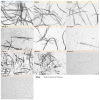Assessment of the Performance of Cationic Cellulose Derivatives as Calcium Carbonate Flocculant for Papermaking
- PMID: 36015566
- PMCID: PMC9414915
- DOI: 10.3390/polym14163309
Assessment of the Performance of Cationic Cellulose Derivatives as Calcium Carbonate Flocculant for Papermaking
Abstract
Cationic polyacrylamides (CPAMs) are usually used as filler retention agents in papermaking formulations. However, increasing environmental restrictions and their non-renewable origin have driven research into bio-based alternatives. In this context, cationic lignocellulosic derivatives have been attracting considerable research interest as a potential substitute. In this work, distinct cationic celluloses with degrees of substitution of between 0.02 and 1.06 and with distinct morphological properties were synthesized via the cationization of bleached eucalyptus kraft pulp, using a direct cationization with (3-chloro-2-hydroxypropyl) trimethylammonium chloride (CHPTAC) or a two-step cationization, where the cellulose was first oxidized to form dialdehyde cellulose and was then made to react with Girard's reagent T (GT). Fibrillated samples were produced by subjecting some samples to a high-pressure homogenization treatment. The obtained samples were evaluated regarding their potential to flocculate and retain precipitated calcium carbonate (PCC), and their performance was compared to that of a commercial CPAM. The cationic fibrillated celluloses, with a degree of substitution of ca. 0.13-0.16, exhibited the highest flocculation performance of all the cationic celluloses and were able to increase the filler retention from 43% (with no retention agent) to ca. 61-62% (with the addition of 20 mg/g of PCC). Although it was not possible to achieve the performance of CPAM (filler retention of 73% with an addition of 1 mg/g of PCC), the results demonstrated the potential of cationic cellulose derivatives for use as bio-based retention agents.
Keywords: calcium carbonate; cationic cellulose; fibrillated cellulose; flocculation; laser diffraction spectrometry; quaternary ammonium.
Conflict of interest statement
The authors declare no conflict of interest.
Figures








References
-
- Shen J., Song Z., Qian X., Liu W. Modification of Papermaking Grade Fillers: A Brief Review. BioResources. 2009;4:1190–1209.
-
- Thorn I., Au C.O., editors. Applications of Wet-End Paper Chemistry. 2nd ed. Springer; Dordrecht, The Netherlands: London, UK: 2009.
-
- Holik H., editor. Handbook of Paper and Board. Wiley-VCH; Weinheim, Germany: 2006.
-
- Biermann C.J. Handbook of Pulping and Papermaking (Second Edition) Academic Press; San Diego, CA, USA: 1996.
-
- Hubbe M.A., Nanko H., McNeal M.R. Retention Aid Polymer Interactions with Cellulosic Surfaces and Suspensions: A Review. BioResources. 2009;4:850–906. doi: 10.15376/biores.4.2.850-906. - DOI
Grants and funding
LinkOut - more resources
Full Text Sources
Miscellaneous

